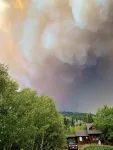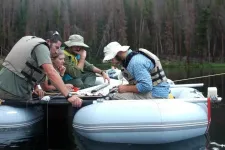(Press-News.org) June 14, 2021 - Last fall, the Mullen fire west of Laramie raged for the better part of two months, burning more than 176,000 acres and 70 structures in Wyoming's Carbon and Albany counties, and in Jackson County, Colo.
Unfortunately, this scenario was typical during the intense 2020 fire season in the Rocky Mountain region, an area of Colorado and southern Wyoming where high-elevation forests are burning more than at any point in the past 2,000 years, according to a study in which a University of Wyoming faculty member was instrumental.
"Global warming is causing larger fires in Rocky Mountain forests than have burned for thousands of years," says Bryan Shuman, a professor in the UW Department of Geology and Geophysics. "The last time anything similar may have occurred was during a warm portion of the medieval era."
Shuman was the main co-author of a paper, titled "Rocky Mountain Subalpine Forests Now Burning More Than Any Time in Recent Millennia," that was published today (June 14) in the Proceedings of the National Academy of Sciences (PNAS). The journal is one of the world's most prestigious multidisciplinary scientific serials, with coverage spanning the biological, physical and social sciences.
Philip Higuera, a professor of fire ecology in the W.A. Franke College of Forestry and Conservation at the University of Montana, was the paper's lead author. Kyra Wolf, a Ph.D. candidate in paleoecology and forest ecology at the University of Montana, also contributed to the paper.
Higuera and Shuman conceived and designed the study, while Higuera and Wolf analyzed the data, a unique network of fire-history records, to understand how current fire activity compared to wildfires of the past. The 2020 fire season marks the emergence of 21st century fire regimes with distinctly higher rates of burning, not only from the late 20th century but relative to the past two millennia.
By November 2020, wildfires in southern Wyoming and northern Colorado were responsible for 72 percent of the total area burned in high-elevation, subalpine forests since 1984. During 2020, Colorado had experienced three of its largest fires on record.
"As the 2020 fire season unfolded, we realized we already had a well-defined understanding of the fire history of many of the places burning, based on over 20 lake sediment records our teams had collected over the past 15 years," Higuera says. "When the smoke settled, we thought 'Wow, we may have witnessed something truly unprecedented here.' So, we combined the existing records for the first time and compared them to recent fire activity. To our surprise, 2020 indeed pushed fire activity outside the range of variability these forests have experienced over at least the past two millennia."
Researchers used charcoal found in lake sediment records to assemble the fire history across the Rocky Mountains. They discovered that, since 2000, wildfires are burning nearly twice as much area, on average, compared to the last 2,000 years.
Over that 2,000-year period, fires in high-elevation, subalpine forest historically burned, on average, once every 230 years. In the 21st century, those fires now occur, on average, every 117 years. This is 22 percent higher than the maximum rate -- which took place during the Medieval Climate Anomaly (770-870) -- reconstructed over the past two millennia. During the Medieval Climate Anomaly, Northern Hemisphere temperatures were 0.3 degrees Celsius above the average in the 20th century.
"The results indicate that, if fires continue to burn as often as they do now, every forest in the region could be burned by the beginning of the next century," Shuman explains. "In the past, it would have taken 200 to 300 years, if not longer, for fires to affect that much area."
In the Rocky Mountains of northern Colorado and southern Wyoming, 840,000 acres burned between 1984 and 2019, Shuman says. Another 660,000 acres burned in 2020 alone. Approximately 1.1 million acres burned in the past decade in the Colorado-Wyoming study area, even though only 400,000 acres -- less than half as much -- burned in the previous 25 years, Shuman says.
Subalpine forests are becoming less resilient and more susceptible to fires because the climate is warming. Because humidity was extremely low, temperatures were high, and storm events produced high winds, forest management had little impact on the 2020 fires. They burned designated wilderness and national parks with limited fuel management; heavily managed areas with substantial timber removal; and intact forest and areas with extensive beetle kill. The extreme climate completely overrode all types of forest management, according to Shuman.
"Snowfall in our high-elevation forests is lower now than in past decades, and summers are hotter. The changes convert trees into dry fuel, primed and ready to burn," Shuman says. "With less snow now, the fire season lasts longer than before. When areas burn, the fires are bigger. They can burn longer.
"Then, after the fires, big areas with few live trees mean few seeds to help forests regrow and, even when seeds are plentiful, seedlings can often die from drought and heat," he continues. "Some forests may never grow back."
"It isn't unexpected to have more fires as temperatures rise. Our records show that fire tracked past variations in climate just as it does today," Wolf adds. "What's striking is that temperatures and, correspondingly, fire are now exceeding the range that these forests have coped with for thousands of years -- largely as a result of human-caused climate change."
Continual warming will reinforce newly emerging fire activity in these high-elevation forests, with significant implications for ecosystems and society, according to the paper.
"It may sound dire, but it's critical to remember that we have ample opportunities to limit or reverse climate warming, while still working to adapt to the increasing fire activity expected in upcoming decades," Higuera says.
Shuman helped plan the study, which came about because of more than $600,000 in grants he was able to obtain from the National Science Foundation to support undergraduate and graduate student research at UW.
"We were able to examine the 2020 fire season because of a decade of student projects at UW that revealed how often our forests have burned in the past few thousand years," Shuman says.
INFORMATION:
ITHACA, N.Y. - Most sensible air travelers dread turbulence. A little atmospheric hiccup can shake airplanes, rattle nerves and spill beverages. A Cornell University-led study found that birds don't mind at all.
By combining wind speed data with the measured accelerations of a golden eagle outfitted with GPS tracking instruments, the researchers suggest that, rather than hindering flight, turbulence is a source of energy that birds may use to their advantage.
This counterintuitive discovery could revise what we know about avian flight, and help the aerospace industry develop faster, more efficient ways to fly in turbulent environments.
The paper, ...
Pancreatic cancer is an aggressive disease in which malignant cells form in the tissues of the pancreas, a long and flat gland located behind the stomach that helps with digestion and blood sugar regulation. Because pancreatic cancer is difficult to detect early, it is associated with a low survival rate, accounting for just over 3% of all new cancer cases in the U.S., but leading to nearly 8% of all cancer deaths, according to the National Cancer Institute.
Through a pre-clinical study conducted in his former role at Moffitt Cancer Center and published in Clinical Cancer Research, Said Sebti, Ph.D., associate director for basic research at VCU Massey Cancer Center, identified a novel drug that effectively thwarts pancreatic tumors that are addicted ...
Analyzing how people move about in their daily lives has long been important to urban planners, traffic engineers, and others developing new infrastructure projects.
But amid the social restrictions and quarantine policies imposed during the global spread of COVID-19--which is directly linked to the movement of people--human mobility patterns changed dramatically.
To understand just how COVID-19 affected human movement on a global scale, Shouraseni Sen Roy, a professor in the College of Arts and Sciences Department of Geography and Sustainable Development, and graduate student Christopher Chapin developed COVID-19 vs. Human Mobility, an innovative and interactive web application that, shared in a new ...
In polymicrogyria, the cortex of the brain has many irregular, small folds (gyria) and disorganization of its layers. Many affected children have severe developmental delay, intellectual disabilities, and epilepsy, and many need to use a wheelchair. Mutations in several different genes can cause this "overfolding of the brain" condition.
Studying four patients with polymicrogyria, Richard Smith, PhD, identified mutations in a gene that caused him to do a double-take. His curiosity drove him to investigate the role of this gene, called ATP1A3, in the developing brain.
"ATP1A3 is critical to many cell biological processes," says Smith, an investigator the Division of Genetics and Genomics at Boston Children's Hospital. ...
Those who deactivated their Facebook profiles report a lower regard for other ethnic groups, and this effect was more prevalent among people living in more ethnically homogenous areas, shows a new study of users in Bosnia and Herzegovina (BiH). The findings run counter to a commonly held view that social media usage exacerbates societal polarization.
The work, conducted by researchers at New York University's Center for Social Media and Politics (CSMaP), appears in the Proceedings of the National Academy of Sciences (PNAS).
"For all our attention to the online drivers of polarization, we should not forget about the importance of offline factors as well," ...
MISSOULA - Following 2020's extreme fire season, high-elevation forests in the central Rocky Mountains now are burning more than at any point in the past 2,000 years, according to a new University of Montana study set to publish in the Proceedings of the National Academy of Sciences.
Researchers from UM and the University of Wyoming analyzed a unique network of fire-history records to understand how 21st-century fire activity compares to wildfires in the past. The findings highlight that burning in recent decades in high-elevation forests of northern Colorado and southern Wyoming is unprecedented over the past several millennia.
As fire paleoecologists - scientists who study historical ecosystems - the team uses charcoal found in lake sediments to piece together the fire ...
PULLMAN, Wash. - You can take a fish out of toxic water, but its epigenetic mutations will remain for at least two generations.
A research team led by Washington State University scientists analyzed the epigenetics--molecular factors and processes that determine whether genes are turned on or off--of a group of Poecilia mexicana fish, or Atlantic molly, that live in springs naturally high in hydrogen sulfide, which is normally toxic to most organisms.
The researchers removed a sample of fish from the toxic water and bred them in freshwater. They found that the grandchildren of the sulfidic-adapted fish had more epigenetic marks ...
EVANSTON, Ill. --- The human gut is more than a source of instinct.
A new Northwestern University study is the first to explicitly address the gut microbiome as a pathway to understanding how environmental inequities could lead to health disparities.
Biological anthropologist Katherine Amato, assistant professor of anthropology at the Weinberg College of Arts and Sciences at Northwestern, is the study's lead author.
Amato says, despite a rich body of literature documenting environmental impacts on the microbiome, and the microbiome's impact on human health, ...
International team used the stomach bacteria Helicobacter pylori as a biomarker for ancient human migrations
DNA sequences catalogued at University of Warwick in EnteroBase, a public genomes database, demonstrate that a migration of Siberians to the Americas occurred approximately 12,000 years ago
Project began in 2000s but new statistical techniques allowed researchers to reconstruct and date the migrations of Siberian Helicobacter pylori
Early migrations of humans to the Americas from Siberia around 12,000 years ago have been traced using the bacteria they carried by an international team including scientists at the University of ...
Certain patients with an aggressive form of ovarian cancer have a better chance of a cure through surgical removal of their tumor before chemotherapy instead of the reverse, a new study shows.
Led by researchers at NYU Grossman School of Medicine, Perlmutter Cancer Center, and Dana-Farber Cancer Institute, the study used a mathematical tool to examine how doctors should coordinate available treatments for high-grade serous ovarian cancer (HGSC).
Ovarian cancer is the 8th most common cancer and cancer death in women worldwide, and HGSC constitutes roughly 70 percent of ovarian malignancies and has the worst prognosis. Patients with the condition typically undergo surgery and chemotherapy, but there has been long-standing controversy over the best order of treatment.
Published ...



